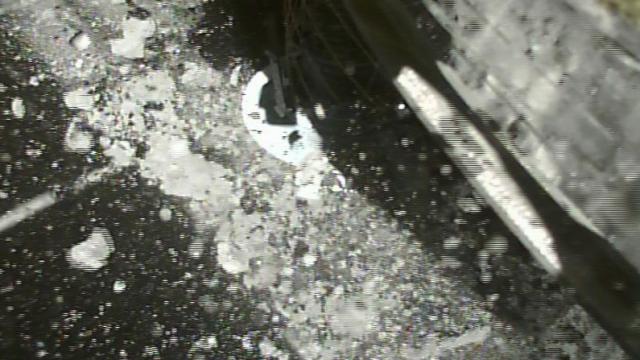On Friday, Japan’s Hayabusa2 may have become the first probe in history to collect material from beneath the surface of an asteroid – a mission that could yield important new insights about the early stages of our solar system. The attempt alone is an exciting achievement, but we won’t know for sure whether the probe successfully gathered samples until it returns to Earth next year.
“From the data sent from Hayabusa2, it has been confirmed that the touchdown sequence, including the discharge of a projectile for sampling, was completed successfully,” the Japan Aerospace Exploration Agency (JAXA) announced in a press release issued earlier today.
The probe performed its brief touchdown at 10:06 a.m. Japan time and is functioning normally, according to JAXA.
[PPTD] These images were taken immediately after today’s touchdown (Jul 11) with the ONC-W1. First photo was taken at 10:06:32 JST (on-board time) and you can see the gravel flying upwards. Second shot was at 10:08:53 where the darker region near the centre is due to touchdown. pic.twitter.com/6OhrYShz4D
— HAYABUSA2@JAXA (@haya2e_jaxa) July 11, 2019
This is now the second time Hayabusa2 has visited the surface of Ryugu – an 870 metre wide asteroid located 300 million kilometres from Earth. The first touchdown happened this past February, during which time the probe fired a projectile onto Ryugu’s surface, kicking up surface material, which it then collected.
This second visit is notable in that Hayabusa2 attempted to collect subsurface material, which had never been done before. Back in April, the probe fired an “impactor,” a copper bullet, onto Ryugu’s surface, which produced an artificial crater surrounded by underground material.
This stuff is precious to scientists, as it’s shielded from the effects of space weathering, including the effects of cosmic rays and charged particles pouring off the Sun. These samples could shed new light on the origins of the solar system and what it was like billions of years ago.
This second operation to visit the asteroid’s surface began on July 9, with Hayabusa2’s slow journey to the surface starting on July 10.
When it reached a distance of 30 metres, the probe located a marker it had deposited earlier and autonomously adjusted its trajectory accordingly. The probe made a brief landing at a site designated the C01-Cb region, which is around 20 metres from the artificial crater.
The touchdown itself lasted just a few seconds, during which time the probe fired a small projectile onto the surface. This produced a field of floating debris that fell into its collection tube (or so we hope). Hayabusa2 then rose back up to a safe distance, where it will continue to monitor the asteroid and the sampling site.
This mission was potentially risky, as Hayabusa2 had already attempted to gather surface samples, and failure here could’ve disabled the spacecraft, preventing it from delivering its valuable cargo back to Earth. Thankfully that doesn’t appear to be the case, with mission controllers calling today’s landing “perfect.”
“It was a success, a big success,” said Hayabusa 2 team member Takashi Kubota at a press conference held earlier today, as reported by New Scientist. “We achieved success in all scheduled procedures.”
This mission was the last major operation to be performed by Hayabusa2, aside from its journey back to Earth. The probe is expected to return late next year with its samples.
Interestingly enough, the AFP reports, the sample canisters will be deposited into Earth’s atmosphere for re-entry, but the probe itself will remain in space. Accordingly, JAXA is contemplating an extended mission, in which Hayabusa2 could be dispatched to visit yet another asteroid.
